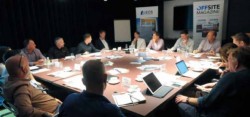EOS recently hosted one of our regular roundtable events - at the heart of the discussion was design for manufacture and assembly (DfMA), the growth of digital design and how these new tools are playing a huge part in the growth of offsite construction activity using the myriad offsite technology options now available.
In 2014 RIBA grabbed many headlines with its DfMA Overlay to the RIBA Plan of Work 2013. The publication represented a major step in offering advice and encouraging early engagement of contractors and manufacturers and makes it clear when offsite methods may be introduced and what the impact on the 'traditional' design process would be when using offsite techniques. Although launched to a minor blaze of publicity the debate on its benefits, and indeed its use, has not been sustained - has the industry really got to grips with it?
The RIBA Overlay was initially developed for project teams to understand what offsite can do and inspire architects to think differently. But the feeling is that this is still not fully understood and the rules not being drilled into a new young
generation of architects and building designers. Architects need to know about the variety of offsite solutions available so they can then recommend the right solution at the right time for the right client.
With many competing offsite systems and materials on the marketplace, all architects and designers are faced with the issue of making these work together successfully. Interfaces and a myriad of components can cause confusion and poor building performance and once again brings into question the demand for an improved flow of offsite processes from the factory to the construction site where thorny - and expensive - concerns surrounding onsite installation can cancel out the plus points created within the manufacturing facility.
RIBA recommends that the design process needs to start with an offsite solution in mind and the RIBA Overlay addresses this by adapting the standard Plan of Work and associated 'RIBA Stages'. The use of offsite technology invariably means that the design process has to be completed in advance of the manufacturing being started. Also inherent is the strong argument that 'early contractor involvement' is the natural direction for offsite manufacturing. As Steve Thompson, Managing Director at EOS, says: "We need a collaborative approach from the beginning of the design with both contractors and subcontractors."
"In theory the Plan of Works Overlay covers all the bases but it has not been particularly well absorbed," says Brendan Geraghty, Director at architects Geraghty Taylor. "The Overlay is a really strong model of how the optimum process should work in a complete cradle to grave cycle.
Everybody's learning quite quickly about new offsite techniques and new offsite technologies. It is a process of educating the profession but it is also a process of educating clients on what can be done if the right 'project culture' is implemented at the start.
Read the full article from the Offsite Magazine here









